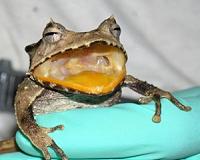| . |  |
. |
Paris (AFP) July 21, 2010 Global warming has been rough on polar bears, but for Colorado's marmots it has meant more food and more sex, according to a unusual study released on Wednesday. Longer summers -- and less time spent burning up stored fat during hibernation -- have given the large burrowing rodents an evolutionary leg up, said the research, published in Nature. Not only has climate change made individual specimens heavier and healthier, it has led to a marmot baby boom as well. Yellow-bellied marmots are awake only four-to-five months of the year, which doesn't leave a lot of time to take care of essential business, explained the study's lead author Arpat Ozgul, a scientist at Imperial College London. "They have to eat and gain weight, get pregnant, produce offspring and get ready to hibernate again," he said in a statement. "Since the summers have become longer, marmots have had more time to do all these things and grow before winter, so they are more likely to succeed and survive." The study is the first to show, for any species, that a shift in seasonal timing can cause changes in body mass and population size at the same time, he said. Analysing data collected over 33 years starting in 1976, Ozgul and colleagues observed that the average weight of adult marmots increased from 3094 grams in the first half of the period to 3433 grams in the second half -- about a ten percent increase. To gather the data, the scientists live-trapped wild marmots at different colonies in the Rocky Mountains and marked them with numbered ear tags, recording sex, mass and, for females, reproductive condition. Population swelled over the last decade, rising from one new member every two years during the period 1976 to 2000, to more than 14 additional marmots every year from 2001 to 2008. While the animals appear to have benefited from rising temperatures in the short run, the good times may not last, the researchers warned. "Will populations thrive in the changing climate? We suspect that this population increase is a short-term response," said Ozgul. Brian Hoskins, director of the Grantham Institute for Climate Change, compared the Rocky Mountain marmots to 'canaries in the coal mine.' "They give us an early warning about the effect for climate change on our natural environment," he said.
earlier related report The disease -- chytridiomycosis -- is advancing trough tropical highlands at about 20 miles a year, causing amphibian die-offs at a rapid rate, ScienceDaily.com reported Tuesday. At one site in Panama, 25 species disappeared between 1998 and 2004, and as of 2008 no examples of the species had reappeared there, researchers say. Using a genetic technique called DNA barcoding, scientists found that five unnamed species unknown to researchers were among those disappearing from the region. "It's sadly ironic that we are discovering new species nearly as fast as we are losing them," said Andrew Crawford of the University of the Andes in Colombia. "Our DNA barcode data reveal new species even at this relatively well-studied site, yet the field sampling shows that many of these species new to science are already gone here." Losing entire species leaves researchers in the dark about the future of affected habitats, one scientist said. "It's like the extinction of the dinosaurs," Karen Lips, associate professor of biology at the University of Maryland, said. "The areas where the disease has passed through are like graveyards; there's a void to be filled and we don't know what will happen as a result."
Share This Article With Planet Earth
Related Links Darwin Today At TerraDaily.com
 Frog Killer Caught In The Act
Frog Killer Caught In The ActWashington DC (SPX) Jul 21, 2010 The first before-and-after view of an amphibian die-off has just been published by scientists working at the Smithsonian Tropical Research Institute in Panama. Like a wave, the fungal disease that wipes out frogs-chytridiomycosis-advances through the Central America highlands at a rate of about 30 kilometers per year. After the disappearance of Costa Rica's golden frogs in the 1980s, Karen ... read more |
|
| The content herein, unless otherwise known to be public domain, are Copyright 1995-2010 - SpaceDaily. AFP and UPI Wire Stories are copyright Agence France-Presse and United Press International. ESA Portal Reports are copyright European Space Agency. All NASA sourced material is public domain. Additional copyrights may apply in whole or part to other bona fide parties. Advertising does not imply endorsement,agreement or approval of any opinions, statements or information provided by SpaceDaily on any Web page published or hosted by SpaceDaily. Privacy Statement |